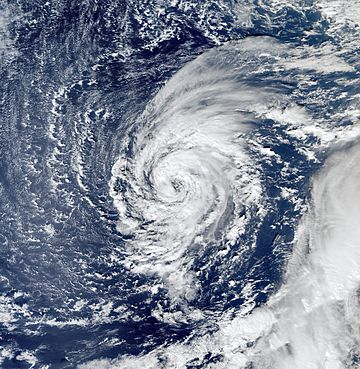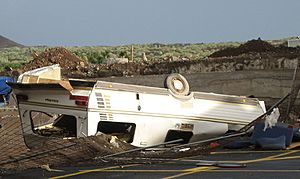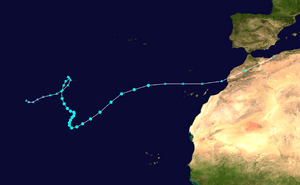Tropical Storm Delta (2005) facts for kids
| Tropical storm (SSHWS/NWS) | |

Tropical Storm Delta near maximum strength.
|
|
| Formed | November 22, 2005 |
|---|---|
| Dissipated | November 29, 2005 |
| Highest winds | 1-minute sustained: 70 mph (110 km/h) |
| Lowest pressure | 980 mbar (hPa); 28.94 inHg |
| Fatalities | 7-19 direct |
| Damage | $364 million (2005 USD) |
| Areas affected | Canary Islands, Morocco, Algeria |
| Part of the 2005 Atlantic hurricane season | |
Tropical Storm Delta was a powerful storm that formed late in the 2005 Atlantic hurricane season. It brought strong winds and heavy rain to the Canary Islands and Morocco. Delta started as a different type of storm before becoming a tropical storm. It was the twenty-sixth named storm of that busy hurricane season.
Delta began as a storm that was not tropical. It slowly gained tropical features. For a short time, it was a subtropical storm. Then, on November 22, it officially became Tropical Storm Delta. The storm moved slowly towards the Canary Islands. It changed back into a non-tropical storm on November 29. This happened just before it passed north of the islands.
Contents
How Tropical Storm Delta Formed and Moved
On November 22, 2005, a weather system in the middle of the Atlantic Ocean started to change. This system was a "low pressure area," which is like a big swirl of air. It began to get some tropical storm features.
Later that day, this low pressure area became Subtropical Storm Delta. It was about 800 miles (1,300 km) west-southwest of the Azores islands. At first, weather experts thought it was already a regular tropical storm. But after looking at the information again, they decided it was subtropical first.
Delta Becomes a Tropical Storm
The storm's center became more organized. On November 24, Delta officially became a tropical storm. It grew even stronger later that day. Its winds reached 70 mph (110 km/h). This was just below hurricane strength. Forecasters thought Delta might become a hurricane, but it did not.
Delta stayed strong for a few days. It moved slowly and in a zig-zag pattern across the central Atlantic. Then, strong "wind shear" started to affect the storm. Wind shear is when winds blow at different speeds or directions at different heights. This can weaken a storm.
Delta Weakens and Changes Again
Delta began to weaken on November 25. By the next day, it was a very weak tropical storm. Some computer models showed that a new storm forming nearby might absorb Delta. This new storm later became Hurricane Epsilon. However, Delta was not absorbed. Instead, it started to move towards the northeast.
As Delta sped up towards the Canary Islands, it got stronger again. On November 27, its winds reached nearly hurricane strength for a second time. Weather experts later thought Delta might have briefly reached hurricane strength that day. But there was not enough clear information to officially call it a hurricane.
On November 28, Delta moved closer to the Canary Islands. It began to lose its tropical storm features. It changed into a strong "extratropical storm." This type of storm gets its energy from temperature differences, not warm ocean water. Even as an extratropical storm, Delta still had winds near hurricane strength. It passed about 105 miles (165 km) north of the islands that night. The storm then moved over Morocco early on November 29. It quickly weakened over land and disappeared later that day over northwestern Algeria.
Impact of Tropical Storm Delta

Tropical Storm Delta caused a lot of damage in the Canary Islands. People there called it a "historic" event. This is because hurricanes are very rare in that area. The islands of Tenerife and La Palma were hit the hardest. Many trees were knocked down, and there were many landslides.
The strongest wind gust recorded on La Palma was 95 mph (152 km/h). On Tenerife, the strongest gust was 90 mph (147 km/h). One hospital had to be emptied. Several airports across the islands were closed. More than 225,000 homes and businesses lost electricity. Many people also lost telephone service.
Damage to Landmarks and Lives
A famous natural landmark called El Dedo de Dios (or God's Finger) was destroyed. This was a rock formation that looked like a finger pointing to the sky. It had been there for over a thousand years. Delta's strong winds and waves broke it apart along the coast of Gran Canaria. Gran Canaria also saw much damage to its old buildings. Centenary windows and crosses were destroyed. The cover of the Cueva Pintada in Galdar was also damaged. Several villages in the center of the island lost power and were cut off.
Sadly, the storm led to the loss of seven lives. Six people were immigrants on a boat that sank near the Canary Islands. Twelve others from that boat were reported missing. Another person died after being thrown from a house by the strong winds while trying to fix it during the storm.
Financial Costs and Other Effects
The total damage from Tropical Storm Delta in the Canary Islands was estimated to be over €312 million. This is about $364 million in 2005 US dollars. Delta also caused a 10-15% drop in the islands' tuna catch. This was because fishermen had to stay in port for several extra days.
In Morocco, Delta was described as a "normal atmospheric disturbance." No damage was reported there. In fact, farmers welcomed the rain. They needed it to help their cereal crops grow.
Naming and Records Set by Delta
When Subtropical Storm Delta formed on November 22, it set a new record. It was the first time that twenty-six tropical or subtropical storms had formed in the Atlantic during one hurricane season. Delta also helped make the 2005 season the busiest ever for the number of storms.
Related pages
|
Tropical cyclones of the 2005 Atlantic hurricane season |
|||||||||||||||||||||||||||||||||||||||||||||||
|
|
||||||||||||||||||||||||||||||||||||||||||||||
|
|
|||||||||||||||||||||||||||||||||||||||||||||||
See also
 In Spanish: Tormenta tropical Delta (2005) para niños
In Spanish: Tormenta tropical Delta (2005) para niños



